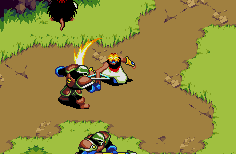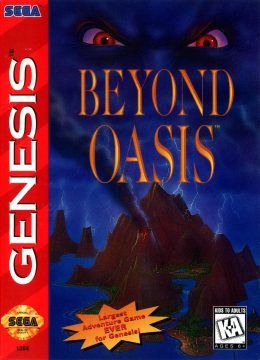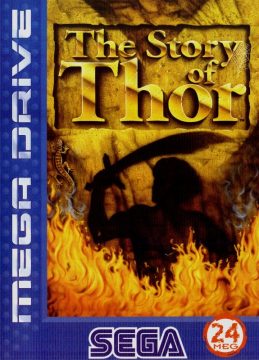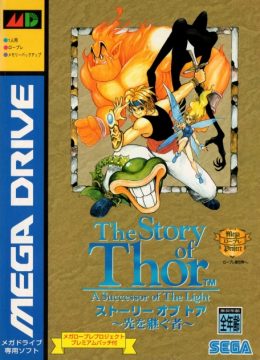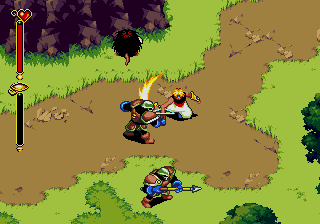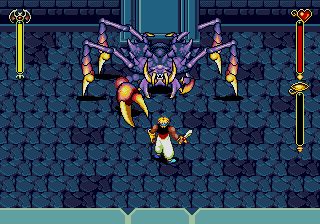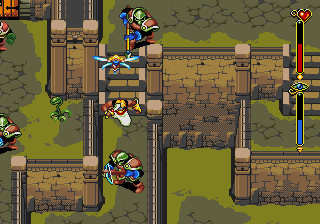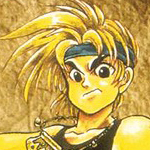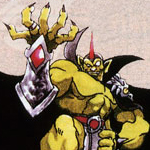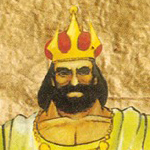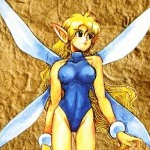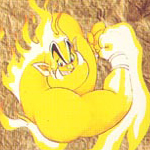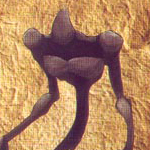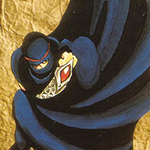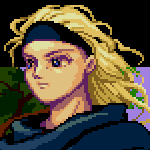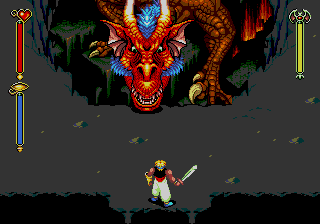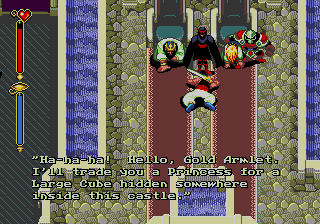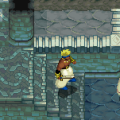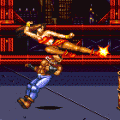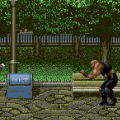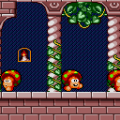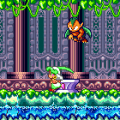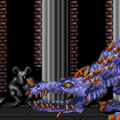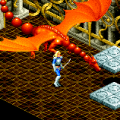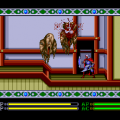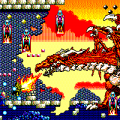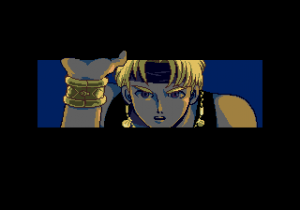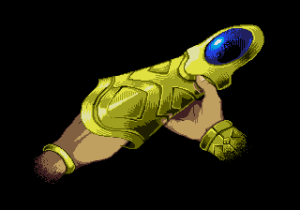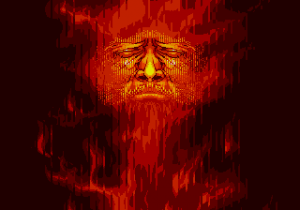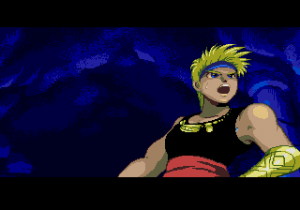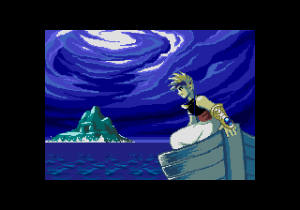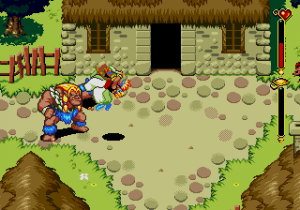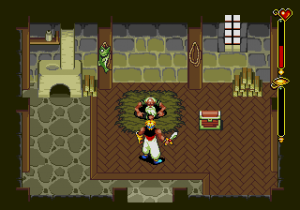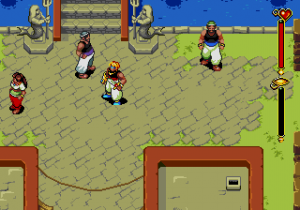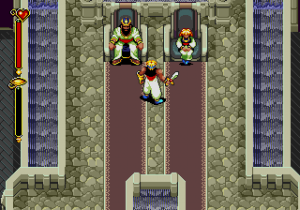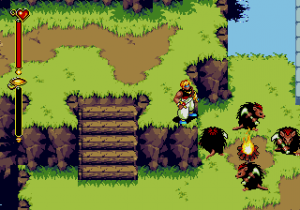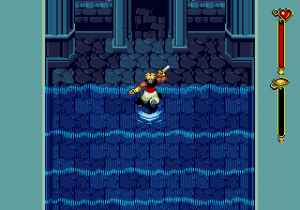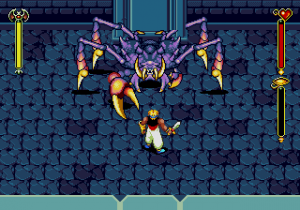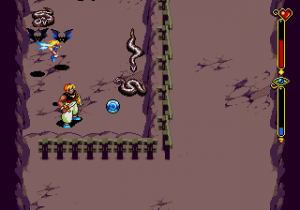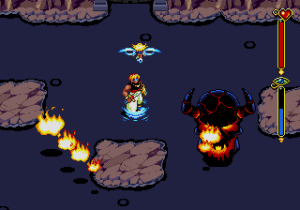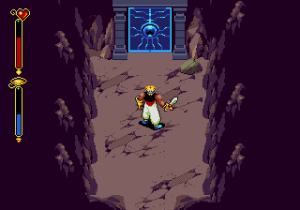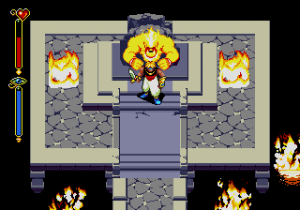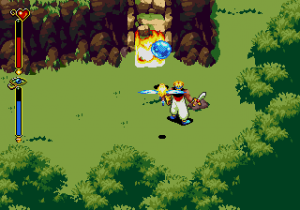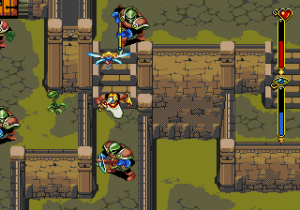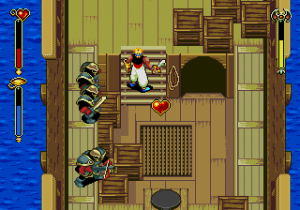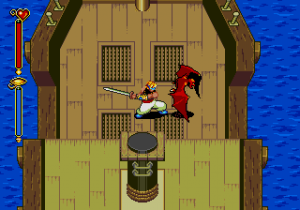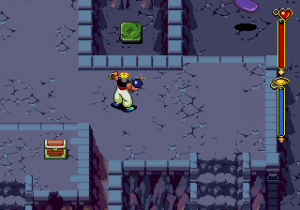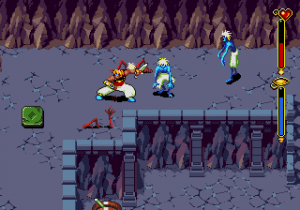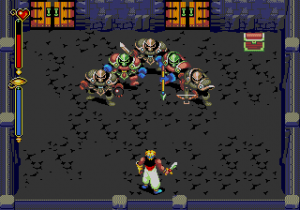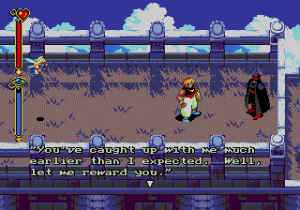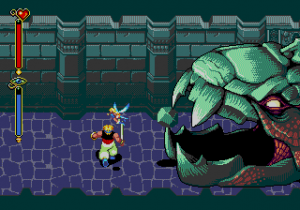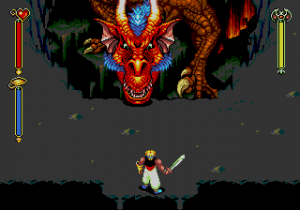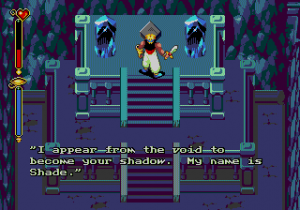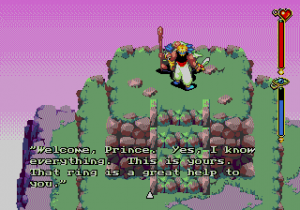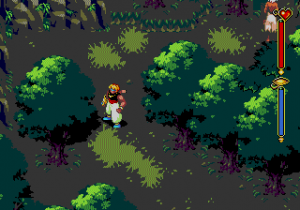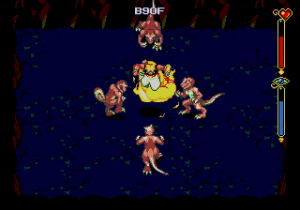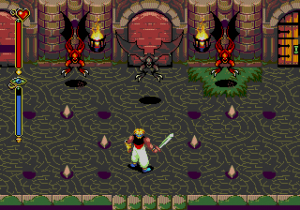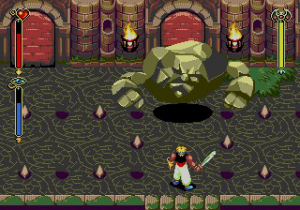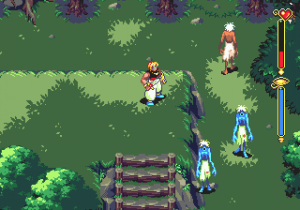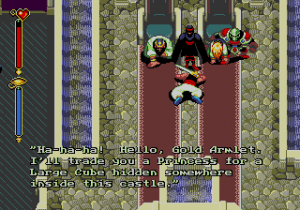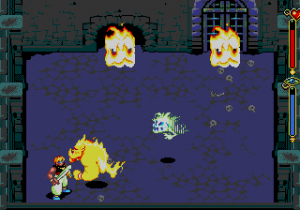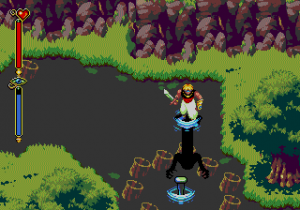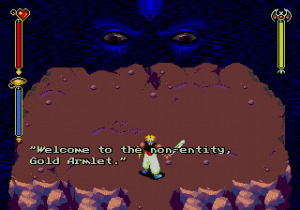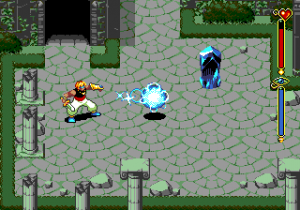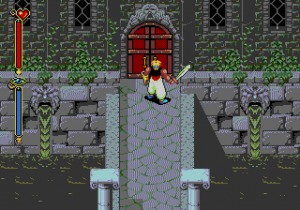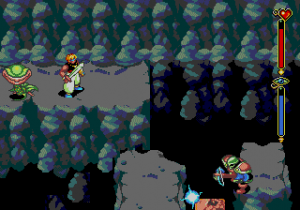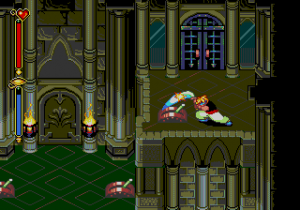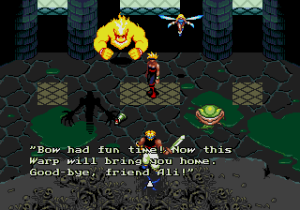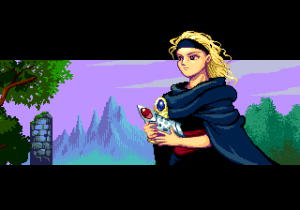- Beyond Oasis
- Legend of Oasis, The
Perhaps it’s got a bad rap, but the Genesis is not remembered for its RPG library. Despite being the home of such classics as Phantasy Star IV, Shining Force, and Lunar, Sega’s 16-bit hardware built its name with platformers and secured its legacy with action games. By 1994 this was a weakness that Nintendo was fully exploiting in Japan with a strong Super Famicom RPG lineup spearheaded by the wildly successful Final Fantasy series. Sega of Japan prepared a bold response called the “Mega Roleplay Project” – an attempt to reverse their fortunes by giving the ailing Mega Drive RPG suite a seismic kick in the pants.
Seven RPGs were born from this movement: the first two Dragon Slayer: Legend of Heroes games, Shining Force CD, Surging Aura, After Armageddon Gaiden, and The Story of Thor. Shining Force CD and Ragnacenty (known as Crusader of Centy and Soleil in North America and Europe, respectively) were localized immediately, and The Story of Thor was also released under the name Beyond Oasis in the United States. Of the Mega Roleplay Project games, Beyond Oasis stands today as the most unique and perhaps also the most tragically underrated and overlooked.
Beyond Oasis was followed in 1996 by The Legend of Oasis for the Sega Saturn. Legend is a chronological prequel with a retconned spirit lineup and subtly different combat scheme. Both games are top-down Action RPGs, but only in the loosest sense – they run light on the stats and heavy on the exploration and fighting. They’ve been called everything from beat-em-ups to adventure games, but they are probably best described as a fusion of several genres and styles. Visually they sport all the romanticism of pre-Islamic Persia as seen in Prince of Persia. They also share that franchise’s emphasis on running, jumping, and free mobility. Their item, weapon, secret, and puzzle systems draw connections to the seminal Legend of Zelda franchise.
But the series’ most memorable hook is the Familiar system involving the Elemental Spirits. Over the course of each game you can summon various magical beings from in-world objects using a “light ball” projectile. If you shoot your light ball at a tuft of grass, for instance, a plant spirit will appear like a genie from a bottle. Shooting at steam, rain, puddle monsters, or the ocean will summon a water spirit. Reflective surfaces produce a third spirit, and flames (even from your own bombs!) can be used to summon yet another. You can only have one spirit present at a time, but you can control them with the A button to fight enemies, heal you, or solve puzzles. Over time these actions drain your magic meter, which can be replenished with food items, sunlight, or magic circles on the ground.
Although the Oasis games are largely unknown, they were created by Ancient – a studio that has not been forgotten over the years thanks to Yuzo Koshiro, its star talent and current CEO. As the composer for Shinobi, ActRaiser, and Streets of Rage, Yuzo Koshiro remains a celebrity in the classic gaming world. It’s true that his Oasis scores are somewhat controversial, but it’s important to note that as an Ancient game, Beyond Oasis shares the same pedigree as Streets of Rage 2 and bears similarities to that acclaimed brawler in its combat system. In fact, that beat–em-up sensibility is the first of several factors that makes Oasis a series worth looking into even today.
Most action RPGs of the era (and indeed since) have limited the player’s combat options to hammering the attack button. Oasis takes a pretty unique approach to combat by giving you special moves and different attacks to use in addition to an arsenal of swords, bombs, and bows. These special moves are performed with simple controller actions such as “Forward, Backwards, Forward + Attack”, “Forward, Forward, Forward + Attack” and so on, similar to what you might see in a versus fighting game or, perhaps, a beat-em-up. It’s impossible to understate what an improvement this is over the one-button combat we’re used to. All the running, jumping, kicking, crawling, and circle-slashing give the games a red-blooded boldness and high replay value.
Deep in the histories of the island kingdom of Oasis, legend tells of magical powers and an epic battle between two wizards. The first was named Reharl, a wise mage who possessed an arcane Gold Armlet that gave him dominion over the spirits of nature. The second was Agito, a dark sorcerer whose Silver Armlet could summon monsters, ghouls, and the undead. It was inevitable that the two should come into conflict, and in the Shadowlands of Oasis their duel brought down ruin on their own heads. The two wizards were seemingly killed and their matching armlets were lost to all knowledge.
Centuries later, the crown prince of Oasis – a young treasure-hunter named Ali – is exploring an islet just off the coast when he finds a cave and an unlocked chest. Inside lies the Gold Armlet. The shattered remains of Reharl’s spirit appear to him to deliver a warning: all is not well in Oasis. The Silver Armlet has also been discovered, and events are in motion that will lead to the overthrow of Oasis into darkness and the resurrection of Agito himself. Ali rushes back to the mainland, only to find that the southern village is already under attack by a band of marauders.
Ali’s adventure takes him back and forth across the island of Oasis in search of the four Spirits who swear allegiance to the Gold Armlet. Along the way he learns more about the nature of his enemy and the secrets of both the island and his own royal family. He fights through dungeons, forests, deserts, castles, caves and mountainsides, culminating in a journey to the fabled Shadowlands themselves. There Ali picks through the undisturbed ruins of Reharl and Agito’s struggle and faces the forces of evil for the good of Oasis.
Characters
Ali
The young prince of the island kingdom of Oasis. All we really know about him is that he’s a great fighter and likes looking for treasure in his spare time.
Reharl
A good wizard and the original owner of the Gold Armlet. He appears to Ali in spirit form during the opening cutscene, but otherwise is not present during the rest of the game.
Agito
A dark wizard and the master the Silver Armlet. He was originally a man but has been transformed into something else entirely by his repeated attempts at resurrection.
The Princess
Ali’s younger sister. Ali is very fond of her and is constantly concerned for her safety – something that gets turned against him late in the game.
The King
The good and gentle King of Oasis who has ruled justly for many a year. He tells Ali where the first Spirit Shrines are and generally helps get the ball rolling on the adventure.
Dytto
One of the Elemental Spirits originally sworn to the service of Reharl. Now she joins Ali with the purpose of cleansing the world of evil. She is the Spirit of Water, but her name doesn’t seem to be based off of any real mythology. She is probably the most useful Spirit for general adventuring since she can heal Ali on command. She also can freeze enemies with bubbles, turn into a lethal water spout, and extinguish fire.
Efreet
A fiery elemental whose allegiance is bound to the Gold Armlet. He joins Ali with a similar goal of “burning away the evil in the world”. “Efreet” is an alternate spelling of “ifrit”, a class of evil or mischievous djinn/genie from Arabic folklore. Efreet’s powers are primarily offensive and cover various way of setting things on fire – including detonating everything onscreen. He’s also a pretty good bodyguard since he’ll seek out and punch anything that moves.
Shade
The Spirit of Darkness who ties himself to Ali’s life force in order to protect his master. The general notion of a shadowy spirit of darkness is fairly universal to world mythology. Shade is the best spirit to have for platforming and boss fights for two reasons. First, he can save Ali from pits. Second, he will “absorb” a certain amount of damage, allowing Ali to go toe-to-toe in fights without getting knocked down.
Bow
The peculiar Spirit of Plants who dedicates his appetite to Ali. The name “Bow” has been something of a mystery for quite some time, but it appears that the original Japanese name was intended to be similar in pronunciation to the English word “Bough” – which makes sense for a plant. Bow is probably the most worthless of the spirits and is only really useful when needed for puzzles.
Silver Armlet
Although his identity is shrouded in mystery, it appears that he is a citizen of Oasis who discovered Agito’s Silver Armlet and was thereby enslaved. Now bearing the name of the device itself, Silver Armlet is Agito’s main henchman and temporarily carries out his master’s evil work in Oasis.
The story is fairly threadbare – amounting to just a few brief scenes of dialogue over the course of the game and two cinematic bookends – but the game world is another matter. The island kingdom of Oasis is vividly illustrated and carefully planned. Beaches transition to forests via patches of longer grass, while forests give way to dirt which in turn reveals rocky paths leading to a cave. Rivers flow across multiple screens and your path takes you over and underground through castles, dungeons, and shrines. The character art is superlative across a fairly extensive range of enemies and NPCs. It’s all hand-crafted pixel art. Overall the visuals give the game world a remarkable sense of cohesion, and makes hunting for the island’s many secrets an enjoyable task even after the bulk of the game is over.
And there are many secrets – each spirit’s power is tied to a set of a dozen gems scattered all over Oasis, and finding them for 100% game completion involves a lot of backtracking and hunting. There are also special weapons that have an infinite number of uses (most weapons break after a set number of hits). These infinite weapons can only be attained by passing certain secret challenge areas, such as a 100-level pit leading to a super-powerful sword, or a long series of tricky jumps that yields a bottomless bag of bombs. Chasing all this gear down is quite enjoyable, and getting a cleared save is about the only way to extend the brief campaign past five or six hours since there are no difficulty settings or unlockable modes.
The music is a mixed bag. The soundtrack has long been regarded by fans as one of Koshiro’s weakest. Rather than the techno-jazz tracks that made him famous, Oasis features an orchestral score heavy on synth strings and trumpets – perhaps not the genre best suited to the Genesis sound hardware. Regardless of fan reception, the soundtrack does display a huge range of different tones that underpin the different areas of the island quite well. There’s a lonely, isolated feel to “Indication” as our hero stands on a deserted beach in the driving rain, and the mystic strains of “Evil Territory” lend decayed grandeur to the final castle level. The score was released in 2007 as part of Yuzo Koshiro Best Collection, Vol. 1 along with the Misty Blue and ActRaiser OSTs. Those not wanting to hunt down the out-of-print CD can instead get a dirt-cheap digital copy on iTunes. Perhaps also worthy of mention is Vladimir Bulaev’s high-quality fan re-orchestration of the OST.
A quite recent development is a ROM hack re-translation of the original Japanese Story of Thor by Joao Albertoni. It’s long been known thanks to some comments by the game’s original localization producer that the Sega of America translation was different to a certain degree from the source material. Just how different it is can now be clearly seen in the new translation, which makes an attempt to stay as close to the source as possible. Character names change and lines of dialogue receive altered inflection and specifics. It’s worth a look if you are a long-time fan of the game or a newcomer interested in a more authentic take on what story there is.
As far as versions go, there’s really only one. If original hardware or aftermarket eBay prices aren’t your flavor, Sega also published the game on the Wii Virtual Console in 2007. Oasis also made the cut for Sonic’s Ultimate Genesis Collectionso you can play it on your HD consoles as well. Either way, it’s hard to go wrong. The graphics, mechanics, gameplay, and control are a stellar total package and well worth the look for the price of admission. Indeed, if there’s any criticism to be leveled against Beyond Oasis, it’s that it’s too brief by far. It is perhaps a reason that it wasn’t more of a hit in its day, along with its late release in the Genesis life span. 32-bit systems were knocking on the door, and many quality games got lost in the shuffle. Still, it’s a mad rush of stellar production value while it lasts.
